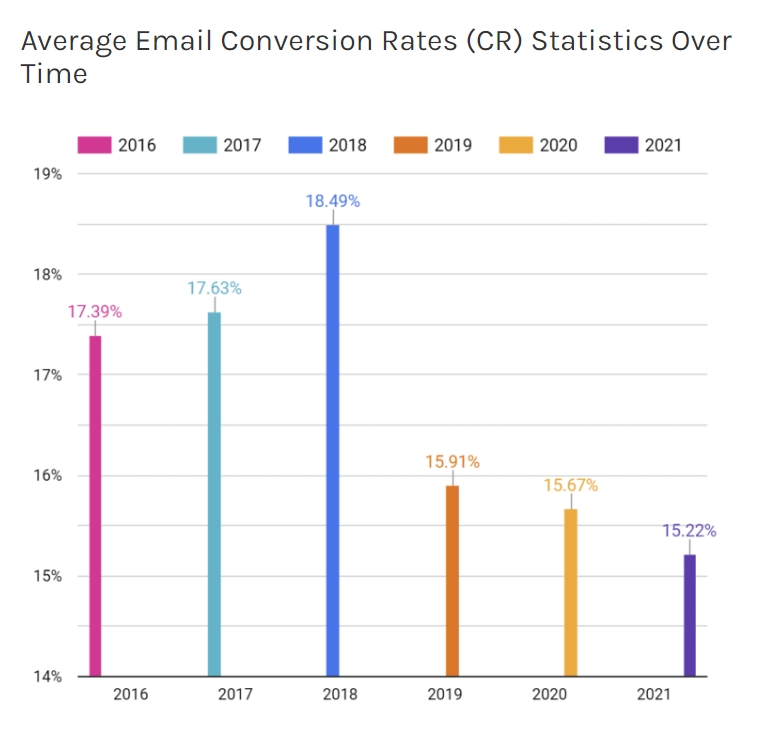The 1-2-3 Guide to Improving Email Conversion Rate
Email marketing is one of the most powerful tools companies have. It enables them to reach out to customers and prospects directly and personally. With the right strategy, companies can stay top-of-mind with their target audience and build relationships that can lead to increased email conversion rates, leading to growth and increased profits.
While it’s true that investment in email marketing software saw a slight decrease to 68% from 75% in the last year, it remains one of the top strategies for reaching and engaging customers. According to updated research, 83% of B2B marketers use email engagement as a content performance metric, while 59% say they use email subscriber numbers for success.
With roughly 83% of B2B marketers stating that they publish their email newsletters, one metric that marketing teams rely heavily on is their email conversion rate. Below, we’ll discuss why this is such an important metric and how you can improve it to help you reach your marketing goals.
Key Takeaways
- With an average of 306 billion emails sent daily, you need to stand out from the crowd to meet your desired email conversion rate.
- Email recipients open 21% of emails within the first hour of delivery. You need to optimize your email design and content to ensure that your addressees open your email and take the desired action.
- With the growing use of mobile devices, optimizing for mobile is more important than ever, with mobile email open rates making up roughly 41.6% of all email opens.
What Is an Email Conversion Rate?
An email conversion rate is a measure of success for email campaigns. It is the number of recipients who take the desired action after opening an email divided by the total number of emails opened. Email conversion rates track things like sign-ups, purchases, and other valuable actions customers take from receiving and engaging with your emails.
Ultimately, it is a metric that tells you how effective your emails have been in getting customers to take the desired action. This information is why defining email conversion rate can be tricky for marketing teams because the desired outcome can and usually does change each campaign.
For example, a demand generation campaign might be looking to drive website traffic and increase sales. The conversion rate may come from the total number of sales from those who clicked through to a specific landing page from the email and completed the purchase. The success metric here is the number of sales made.
However, if you’re looking to build brand awareness and get more names on your subscriber list, the conversion rate would be defined as the number of subscribers gained divided by the number of emails sent.
Despite the many ways to define conversion rate, it’s still crucial to note that email remains a highly effective channel for driving purchases. Even with the average email conversion rate dropping to 15.22%, down from its peak in 2018 of 18.48%, studies continue to show that email accounted for 18.8% of all e-commerce transactions, falling third after paid search (19.9%) and organic traffic (21.8%).

Calculating Your Email Conversion Rate
While there are many ways to define email conversion rate, the formula attaches to the number of emails sent out and the desired outcome of the email, such as a sale or sign-up. The calculation is simple:
You divide the number of completed actions by successfully delivered emails. Then you multiply that number by 100 to get your final percentage.

For example, if you sent out 100 emails, 85 were successfully delivered, and you received a total of 25 completed actions from that email, your calculation would look like this:
Email Conversion Rate (%) = (25/85) x 100
Email Conversion Rate = 29.4%
5 Ways You Can Improve Your Email Conversion Rate
Email is a powerful marketing tool, but converting your emails can take time and effort. Many factors go into a successful email marketing campaign, from crafting the perfect subject line to creating effective calls to action. Here are five tips to help you get the most out of your email marketing efforts and improve your conversion rate.
1. Segment Your Email List
One of the most important things you can do to improve your email conversion rate is to segment your list. Segmentation allows you to send more targeted emails, which are more likely to resonate with your readers. Segmentation will help you reach the right people with the right message, making your efforts more likely to succeed. It also gives you the ability to track the performance of different segments.
2. Pay Careful Attention to Your Subject Line
Your subject line and preview text are often the first things your readers will see, so you must make sure they pack a punch. You should include keywords that are relevant to your content, craft a catchy subject line, and include a benefit or call-to-action that compels readers to open and read the email.
It’s also essential to ensure your subject line is the correct length – shorter subject lines are better for mobile devices. Keep it concise and to the point, and you’ll be sure to capture your reader’s attention.
3. Incorporate Strong Calls to Action (CTAs)
Creating a strong call to action (CTA) is essential for improving your email conversion rates. A CTA should be the primary focus of your email, and it should be easy for readers to spot.
Ensure that it is clear and concise and outlines the benefit of completing the action you are asking for. Additionally, make sure your CTA stands out from the rest of your content by using bold colors and visuals.
4. Always Test Before You Send
Before sending any emails, testing them to ensure they are correctly working is important. Testing ensures that your emails look good across different devices and browsers and that all links work correctly.
You should also test the layout, images, and subject line to make sure that everything looks and reads as you intended. A/B testing is also a great way to test different versions of your emails to see which one performs better.
5. Create an Automated Drip Campaign
Creating an automated drip campaign is another excellent way to improve your email conversion rate. With this type of campaign, you can send targeted emails to users on a set schedule. This schedule allows you to stay top-of-mind with your readers and keep them engaged with your content. Additionally, automated drip campaigns will enable you to track user behavior and adjust your messages accordingly.
Making the Most of Your Email Marketing with Televerde
You can make the most of your email marketing efforts by taking these steps to improve your email conversion rate. With an effective campaign, you can reach more people and engage more customers, leading to increased sales.
Televerde can help you design and execute a successful email marketing campaign. With our available email templates, we can maximize the impact of your messages and help you reach your desired results with our advanced analytics and insights to help you monitor your outcomes.
Ready to see how Televerde can assist you? Contact our team today to get started!


